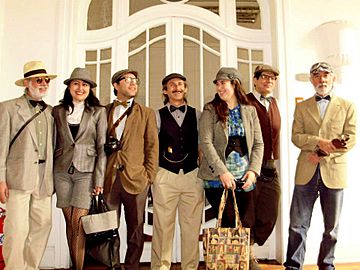Neo-Victorian facts for kids
Neo-Victorianism is a modern style that shows a strong love for the Victorian era. This was a time in history when Queen Victoria ruled England (from 1837 to 1901). People who like Neo-Victorianism enjoy bringing back Victorian ideas, fashion, and art into today's world. It's like looking back at the past but also making it new and different. This can make it tricky to define exactly what Neo-Victorian art is.
Contents
Neo-Victorian Art and Crafts
In the world of art and crafts, Neo-Victorianism means making new things look old. For example, you might see a modern push-button phone designed to look like an old wall-mounted telephone. Or a CD player that looks like a radio from a long time ago. People also create furniture and clothing that look like they came straight from the Victorian era.
This style often appears in fantasy art and a popular type of art called steampunk. Steampunk mixes Victorian style with futuristic or fantasy technology. Some artists, like McDermott & McGough, even try to live like people from the 1800s. They use old photography methods to create their art, keeping the feeling of a forgotten time alive.
Neo-Victorian Stories and Movies
Neo-Victorian stories are books, movies, or TV shows that are set in the Victorian period but are created by modern artists. These stories often look at Victorian culture in new ways.
Many famous books have explored Neo-Victorian ideas, like The French Lieutenant’s Woman by John Fowles and Possession by A. S. Byatt. These books often rewrite or reinterpret what life was like back then.
Lots of these Neo-Victorian books have been made into movies or TV shows. For example, The French Lieutenant’s Woman became a film. TV shows by Sarah Waters, such as Tipping the Velvet and Fingersmith, are also popular examples. These stories sometimes show a more exciting or surprising side of the Victorian era.
You might have seen other Neo-Victorian shows on screen, like Guy Ritchie’s Sherlock Holmes movies or TV series like Sherlock, Ripper Street, and Penny Dreadful. Even shows like Downton Abbey and The Paradise, which are set a little later in the Edwardian era, share a similar style.
Neo-Victorian Fashion and Habits
Many people who enjoy Neo-Victorian style also try to act like Victorians. They might try to speak and behave in ways that were common back then. Some even adopt Victorian habits, like shaving with straight razors or riding penny farthing bicycles. They might also exchange calling cards or write letters with fountain pens using fancy language and sealing them with wax.
You can sometimes see Neo-Victorian style mixed with Gothic fashion. There are also fashion styles from Japan, like Lolita fashion and Aristocrat, which share some similarities with Neo-Victorianism.
Neo-Victorian Ideas in Society
Neo-Victorian styles and ideas are also popular among people who want to bring back older ways of thinking. In countries like the United States and the United Kingdom, some groups believe we should return to the manners and morals of the Victorian era. Books like The Benevolence of Manners encourage people to live more gracefully, like Victorians.
However, it's important to remember that some common ideas about the Victorian era might not be completely accurate. Many things we think of as modern, like advertising and popular products, actually started during the Victorian age.
Researching Neo-Victorianism
Many experts study Neo-Victorianism. For example, The University of Exeter held a big meeting in 2007 to discuss this topic. There are also many academic books and papers that explore how the Victorian era is shown in the 21st century. These studies help us understand why people are still so interested in this period today.
See also


